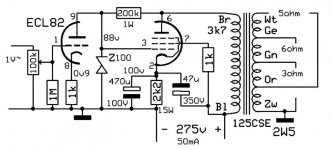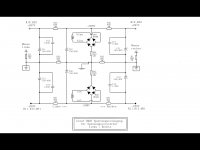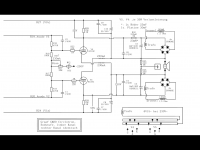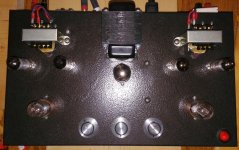Yes, looks allmost the same. Seems everyone is inventing the wheel over and over again.That looks an awful lot like this:
http://www.diyaudio.com/forums/tubes-valves/136179-schadeode.html
Mona
Minimal does not mean simple, and we all know that to make something minimal is much less simpler than making ordinary things. 😀
To do the same thing but without the transistor, perhaps like this ?
Interesting, Ketje. Could one use a voltage regulator tube (e.g. OB3 or OC3) in place of the 100V zener, or would that be too noisy to be attached to the output tube's grid? Would there be enough voltage at startup to get it to spark?
That zener never conducts (if everything goes well) It's only to prevent catastrophic current in the pentode if the triode fails or warms up too slow.
Mona
Mona
Minimal does not mean simple, and we all know that to make something minimal is much less simpler than making ordinary things. 😀
+1000
To do the same thing but without the transistor, perhaps like this ?
Mona
Thanks Mona,
That one looks nice... though I have no idea what a zener is. Gotta look it up.
What would the sonic characteristics of that circuit more or less?
> simplest, most minimalistic, best sounding tube amp circuit ever made.
> I come from guitar-amp-city
> talk about "most famous" or revered
Fender AA-Champ. Omit first stage, tone-stack. Reduce NFB resistor from 2.7K to maybe 1K. Use a hi-fi rated OT. Do it twice for stereo.
It is a good cleanish (with NFB mod) design, just enough power for not "very loud" in efficient speakers (for some definitions of "loud"). It is in a tie with 5F6a for "most revered tube amp of all time", and the AA-Champ is far cleaner than the 5F6a.
You can find essentially the same plan, with many different tubes, published as lo-power hi-fi amp plans from tube factories and popular magazines of the 50s and 60s.
I would tend to 300V-350V of B+ rather than the 350V-420V seen in later Champs, because your hi-fi OT will likely be 5K not 7K and because a hi-fi should not be as insane as a g-amp.
Oh, the B+ needs one more stage of R-C filtering to be low-humm in a hi-fi speaker.
"Minimal" strongly suggests Silicon rectyfication, which suggests 240VAC PT.
I obviously like this idea a lot, I'm not inclined to use a bridge rectification though, I think I would prefer using a rectifier tube. I want to keep it old school 😉
Questions:
-What's an "AA" Champ?
-Are there any sort of "classic" or "timeless" amp designs from the 50's or early 60's like in guitar amps? Does the hifi "holy grail" of tone exist?
I just finished building one of the "holy grails" of guitar amps, a true classic. And it is an awesome amp, can't be beaten

That zener never conducts (if everything goes well) It's only to prevent
catastrophic current in the pentode if the triode fails or warms up too slow.
Maybe an NE-2 neon lamp could be used instead?
A diode that does nothing until a indicated voltage is reached (surpassed) and than starts conducting heavely.Thanks Mona,
That one looks nice... though I have no idea what a zener is. Gotta look it up.
Don't know, it resemble the well known RH84 many people like.So who can tell ?What would the sonic characteristics of that circuit more or less?
Mona
I absolutely do not recommend building an amp without having your speakers in mind. Speakers are much more important than an amplifier and are the biggest contributor to overall sound, along with the room.
First question, what is the room dimensions?
Second question, what speakers do you want to use?
If you are stubborn about building the amp first then I recommend something with adequate power and a good damping factor to be safe.

First question, what is the room dimensions?
Second question, what speakers do you want to use?
If you are stubborn about building the amp first then I recommend something with adequate power and a good damping factor to be safe.

Last edited:
These are the speakers I'm aiming for:
TANNOY Lifestyle - Kensington GR
But this amp is going to be a first try. Later I would like to build something a little bit more luxurious-serious so to speak, though I still want to use top notch components with this little one 😉
I like the idea of building a nice simple circuit and then go safari and try different speakers and see which one fits better "in the flesh".
What's the circuit you linked? How is it called?
Thanks
TANNOY Lifestyle - Kensington GR
But this amp is going to be a first try. Later I would like to build something a little bit more luxurious-serious so to speak, though I still want to use top notch components with this little one 😉
I like the idea of building a nice simple circuit and then go safari and try different speakers and see which one fits better "in the flesh".
What's the circuit you linked? How is it called?
Thanks
Last edited:
It's an amplifier in the RCA manual and sounds good, I was going to build it but with the speakers I had I didn't need that much power. The speakers you are interested in are fairly efficient and you can probably get away with a 20 watt amp if the room isn't huge and or you don't need ear piercing levels of playback. I built the Mullard 5-20 circuit with some minimal changes like wiring the front end pentode as a triode. It has a large following, many builders on here have built and are very happy with the results.
I recommend the Mullard 5-20 circuit.
I recommend the Mullard 5-20 circuit.
An externally hosted image should be here but it was not working when we last tested it.
I used graaf gm20 diybuild with tannoy dual concentric for many years.
This otl concept is easy to build. Very good match.
Ronny
This otl concept is easy to build. Very good match.
Ronny
Attachments
Last edited:
Here's another variation on the SE amp theme, but this time the shunt feedback comes from the screen of the output pentode, by way of the output transformer primary's ultralinear tap -- A Single-Ended E-Linear Amplifier
For push-pull, there are many good examples of 10 to 25 watt per channel amplifiers. I think a good 'can't-miss' first build would be something like Morgan Jones' 'Bevois Valley', which is a push-pull EL84 amp with a simple driver/phase splitter using a 6DJ8 (ECC88). A reasonably well-done push-pull EL84 amp can't help but sound nice.
--
For push-pull, there are many good examples of 10 to 25 watt per channel amplifiers. I think a good 'can't-miss' first build would be something like Morgan Jones' 'Bevois Valley', which is a push-pull EL84 amp with a simple driver/phase splitter using a 6DJ8 (ECC88). A reasonably well-done push-pull EL84 amp can't help but sound nice.
--
Last edited:
I am adding my  non valve great sounding system idea which may suit your taste. This would be to partner the classic John Lindsey Hood - boosted to 15 watt w with a pair of Westminster. it is a classic marriage made in heaven.
non valve great sounding system idea which may suit your taste. This would be to partner the classic John Lindsey Hood - boosted to 15 watt w with a pair of Westminster. it is a classic marriage made in heaven.  Driving the JHL is a David Hafler DH101 pre-amp.
Driving the JHL is a David Hafler DH101 pre-amp.
However the electronics quality has been revised to current status. 😀
 non valve great sounding system idea which may suit your taste. This would be to partner the classic John Lindsey Hood - boosted to 15 watt w with a pair of Westminster. it is a classic marriage made in heaven.
non valve great sounding system idea which may suit your taste. This would be to partner the classic John Lindsey Hood - boosted to 15 watt w with a pair of Westminster. it is a classic marriage made in heaven.  Driving the JHL is a David Hafler DH101 pre-amp.
Driving the JHL is a David Hafler DH101 pre-amp.However the electronics quality has been revised to current status. 😀
Just finished a triode EL84 amplifier which runs quite low voltage and can be build for around $1000 canadian,
It has the 'beautiful' tube sound that people want, with high distortions, however the sound is quite good even compared to the best amplifiers, distortion is 0.3% at 1Watt, 0.72% at 2 Watts and 10.4 % at 4 watts (all RMS watts of course!)
Transformer is triode 10 watts, bass is not well defined but all there due to extra harmonics, high frequencies are poor, there is no sparkles of the top end, 'air' is average, instrument separation poor.
this is with 87db speakers, it could be a different story with 95+ speaker.
It has the 'beautiful' tube sound that people want, with high distortions, however the sound is quite good even compared to the best amplifiers, distortion is 0.3% at 1Watt, 0.72% at 2 Watts and 10.4 % at 4 watts (all RMS watts of course!)
Transformer is triode 10 watts, bass is not well defined but all there due to extra harmonics, high frequencies are poor, there is no sparkles of the top end, 'air' is average, instrument separation poor.
this is with 87db speakers, it could be a different story with 95+ speaker.
Attachments
Hi
My definition of minimalist would be the least parts possible.
Here is what I built back when a kit was available but really not hard to assemble your own parts.
http://welbornelabs.com/drd_300b_ss.pdf
Electra-Print.com 300B DRD Audio Tube Amplifier
Good luck
Paul
My definition of minimalist would be the least parts possible.
Here is what I built back when a kit was available but really not hard to assemble your own parts.
http://welbornelabs.com/drd_300b_ss.pdf
Electra-Print.com 300B DRD Audio Tube Amplifier
Good luck
Paul
Minimal? Low power? I'll suggest something similar to that suggested by PRR-
Sort of a HI-FI champ.
single stage 6SL7 or 12AT7 grounded cathode, unbypassed cathode
single 6V6GT or EL84 SE pentode, bypassed cathode or high-current LED(s) for bias
whatever caps and other parts you have on hand
Some basic negative feedback to the first stage cathode (it's only one resistor per channel)
Triad world series 12VAC filament transformer
Triad world series 240VAC B+ transformer (or use a hammond combo for both, I like to use a separate filament tranny these days)
Hammond 125BSE or 125CSE output transformer (could use surplus Fender champ clone for cheaper cost at reduced bass response, also I'm sure there are comparable choices at a better price point nowadays)
Should be cheap, easy, elegant. Can get complicated quick as you tweak and hot rod it.
Sort of a HI-FI champ.
single stage 6SL7 or 12AT7 grounded cathode, unbypassed cathode
single 6V6GT or EL84 SE pentode, bypassed cathode or high-current LED(s) for bias
whatever caps and other parts you have on hand
Some basic negative feedback to the first stage cathode (it's only one resistor per channel)
Triad world series 12VAC filament transformer
Triad world series 240VAC B+ transformer (or use a hammond combo for both, I like to use a separate filament tranny these days)
Hammond 125BSE or 125CSE output transformer (could use surplus Fender champ clone for cheaper cost at reduced bass response, also I'm sure there are comparable choices at a better price point nowadays)
Should be cheap, easy, elegant. Can get complicated quick as you tweak and hot rod it.
Last edited:
- Status
- Not open for further replies.
- Home
- Amplifiers
- Tubes / Valves
- Best "minimal" amplifier circuit






